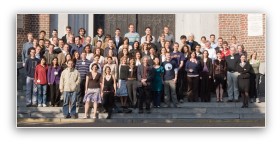News archive
- Details
- Published on 08 April 2008
The results and follow-up of the extensive survey carried out last year by the Astronomy & Astrophysics Editorial Office on the perception of the journal by its authors can now be consulted at: Editorial, A&A 480, E3, (2008) for the full pdf version. For the abstract click here. This is a free access article.
The objective of the poll was to assess the perception of the journal in the community so as to better serve its members.
A&A is now implementing changes where it counts to bring about an even more professional peer-review process, an even faster manuscript handling process and an even greater interaction with the Editors.
- Details
- Published on 15 February 2008
The ADS has developed “Dexter”, a Java applet that supports the user in
the process of generating data points from published figures containing
images, plots, graphs and histograms, whenever the original datasets
used by the authors to produce figures in the papers are not available
electronically. Dexter's basic functional is to let the user manually
digitize a plot by marking points and defining the coordinate
transformation from the logical to the physical coordinate system.
Advanced features include automatic identification of axes, tracing
lines and finding points matching a template.
Please have a look at ADS Dexter help to get more information.
The ADS applet Dexter, which is available under the GNU General Public
License, has been adapted by EDP Sciences to work with A&A articles.
- Details
- Published on 12 December 2007
The new Sect. 15, entitled “Numerical methods and codes” which is devoted to publishing new numerical algorithms and codes of interest, and the Section 12 “Atomic, molecular, and nuclear data” are now published online only. These welcome newcomers add to the other online-only sections: Sect. 13, “Astronomical Instrumentation”, and Sect. 14 “Online catalogs and data”.
See Editorial, A&A vol. 477, issue 1, p. E1 (2008).
- Details
- Published on 23 October 2007
EDP Sciences and A&A are glad to announce the "First Astronomy and Astrophysics School: Scientific Writing for Young Astronomers" which will be held in Blankenberge, Belgium, from 19 to 21 May 2008.
The direct purpose of organising an "A&A School" is to teach young authors how to express their scientific results through adequate and efficient science writing. In other words: how to write scientific papers for different forums (journals, proceedings, thesis manuscripts, etc.).
Visit the website at www.swya.org.
You can download the announcement.
- Details
- Published on 31 July 2007
See Letter from the Board of Directors of Astronomy & Astrophysics, A&A vol. 472, issue 1, p. E9 (2007).
- Details
- Published on 09 July 2007
Don’t think twice, until the end of 2008, take advantage of our color printing offers:
- Free for letters: figures (for which electronic files are provided in color) are published in color free of charge in the paper version.
- 50% reduction on regular papers: this discount is applied to the color figure prices.
- Details
- Published on 09 July 2007
In line with our aims of close collaboration with our scientific partners, we are pleased to inform you that the articles published in section 14 Online catalogs and data are in full Open Access *.
* Articles in section 13 Astronomical instrumentation have already been in full Open Access since the first 2007 issue.
We are confident that these changes will improve the visibility and diffusion of your articles and hope that you will enjoy our new services.
- Details
- Published on 09 July 2007
In the goal of enhancing our services to the astrophysical community, we are pleased to inform you that the letters section is now available in full Open Access until the end of 2008.
We are confident that this change will improve the visibility and diffusion of your articles and hope that you will enjoy our new service.
- Details
- Published on 05 June 2007
The IRAM interferometer, located on the Plateau de Bure at 2500 meters altitude in the French Alps, has entered a new era since the beginning of 2006. The tracks, on which the six 15-meter diameter antennas move, have been extended, nearly doubling the east-west and north-south baselines. The largest separation of the antennas is now 760 meters, enabling sub-arcsecond angular resolution at millimeter wavelengths.
This special issue of Astronomy & Astrophysics Letters presents first results with the extended baselines of the Plateau de Bure interferometer. Eleven Letters report observations done at sub-arcsecond resolution of objects ranging from nearby star-forming regions and evolved stars to starburst galaxies.
The Astronomy & Astrophysics special feature (volume 468 n°3 – June IV 2007) on the extended baselines for the IRAM Plateau de Bure interferometer includes 11 Letters. They are freely available on the A&A web site.
Table of contents of the A&A special feature (and free access to the PDF files)
- Details
- Published on 09 November 2006
Astronomy & Astrophysics introduces a new editorial policy for papers submitted to Section 13 (Astronomical Instrumentation).
See Editorial , A&A 459, E3, (2006)



